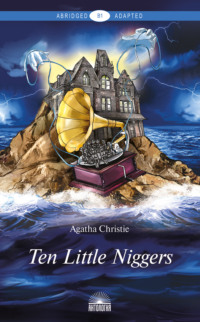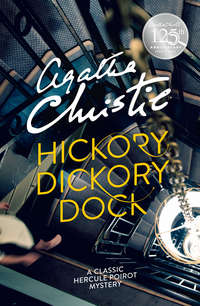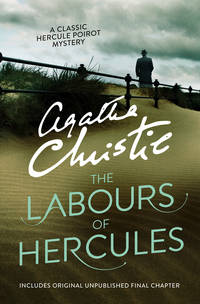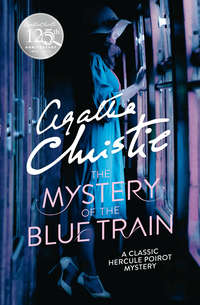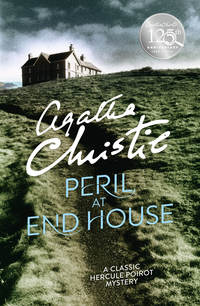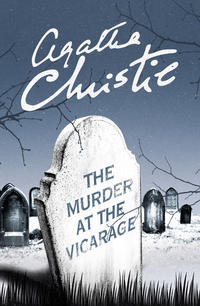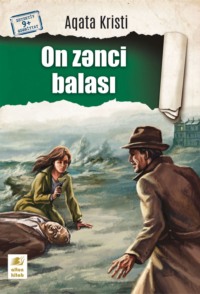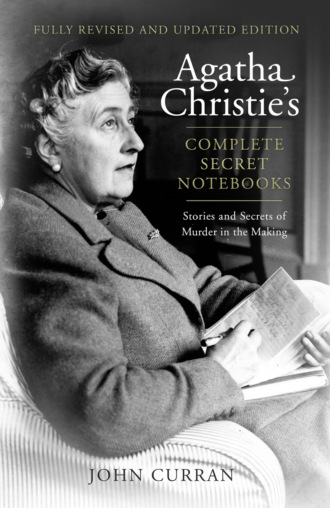
Полная версия
Agatha Christie’s Complete Secret Notebooks


From Notebook 4 a tantalising glimpse of a project, never realised, from the 1960s.


Copyright
Published by HarperCollinsPublishers Ltd
1 London Bridge Street
London SE1 9GF
www.harpercollins.co.uk
Fully revised and expanded edition published 2016
First published in Great Britain in two volumes by HarperCollinsPublishers as Agatha Christie’s Secret Notebooks and Murder in the Making 2009, 2011
Copyright © John Curran 2009, 2011, 2016
Agatha Christie Notebooks, The Man Who Knew, The Incident of the Dog’s Ball, The Case of the Caretaker’s Wife and The Capture of Cerberus copyright © Christie Archive Trust 2009, 2011
Quotations copyright © Agatha Christie Limited 2009, 2011
Agatha Christie®, Poirot®, Marple® and the Agatha Christie Signature are registered trade marks of Agatha Christie Limited in the UK and elsewhere.
All rights reserved
www.agathachristie.com
Cover layout design © HarperCollinsPublishers Ltd 2016
Cover design by Henry Steadman
Photograph of Agatha Christie © Popperfoto/Getty Images
John Curran asserts the moral right to be identified as the author of this work.
A catalogue copy of this book is available from the British Library.
This novel is entirely a work of fiction. The names, characters and incidents portrayed in it are the work of the author’s imagination. Any resemblance to actual persons, living or dead, events or localities is entirely coincidental.
All rights reserved under International and Pan-American Copyright Conventions. By payment of the required fees, you have been granted the non-exclusive, non-transferable right to access and read the text of this e-book on-screen. No part of this text may be reproduced, transmitted, down-loaded, decompiled, reverse engineered, or stored in or introduced into any information storage and retrieval system, in any form or by any means, whether electronic or mechanical, now known or hereinafter invented, without the express written permission of HarperCollins.
Source ISBN: 9780008129620
Ebook Edition © October 2016 ISBN: 9780008129644
Version: 2017-04-11
Dedication
For
Joseph, Conor,
Francis, Oisin and Lorcan
And for
Mathew, Lucy and Mahler,
without whom …
Contents
Cover
Title Page
Copyright
Dedication
Foreword
Introduction
Preface: Shadows in Sunlight
1. The Beginning of a Career
2. The Evidence of the Notebooks
3. Agatha Christie at Work
4. Rule of Three
5. Crime Writers in the Notebooks
Part I: The First Decade
The Mysterious Affair at Styles
The Man in the Brown Suit
The Secret of Chimneys/Chimneys
The Mystery of the Blue Train
My Favourite Stories and ‘The Man Who Knew’
Part II: The Second Decade
‘The Bird with the Broken Wing’
‘Manx Gold’
The Murder at the Vicarage
The Sittaford Mystery
‘The Mystery of the Baghdad/Spanish Chest’
Peril at End House
‘The Second Gong’
‘Death on the Nile’
Lord Edgware Dies
Three Act Tragedy
Death in the Clouds
‘How Does Your Garden Grow?’
The ABC Murders
‘Problem at Sea’
‘Triangle at Rhodes’
‘The Regatta Mystery’
Murder in Mesopotamia
‘Murder in the Mews’
Dumb Witness
‘The Incident of the Dog’s Ball’
Death on the Nile
‘The Dream’
Appointment with Death
‘How I Created Hercule Poirot’
Hercule Poirot’s Christmas
And Then There Were None
Part III: The Third Decade
Sad Cypress
One,Two, Buckle my Shoe
‘Four-and-Twenty Blackbirds’
Evil under the Sun
N or M?
‘The Case of the Caretaker’s Wife’
The Body in the Library
Five Little Pigs
The Moving Finger
Towards Zero
‘Strange Jest’
Death Comes as the End
Sparkling Cyanide
The Hollow
Three Blind Mice/The Mousetrap
The Labours of Hercules
‘The Capture of Cerberus’
Butter in a Lordly Dish
Taken at the Flood
Crooked House
Part IV: The Fourth Decade
A Murder is Announced
They Came to Baghdad
Mrs McGinty’s Dead
They Do It With Mirrors
After the Funeral
A Pocket Full of Rye
Personal Call
Destination Unknown
Spider’s Web
Hickory Dickory Dock
Dead Man’s Folly
‘Greenshaw’s Folly’
4.50 from Paddington
The Unexpected Guest
Ordeal by Innocence
Cat among the Pigeons
Part V: The Fifth Decade
The Pale Horse
The Mirror Crack’d from Side to Side
Rule of Three
The Clocks
A Caribbean Mystery
At Bertram’s Hotel
Third Girl
Endless Night
By the Pricking of my Thumbs
Hallowe’en Party
Part VI: The Sixth Decade
Passenger to Frankfurt
Nemesis
Fiddler’s Three
Elephants Can Remember
Akhnaton
Postern of Fate
Curtain: Poirot’s Last Case
Sleeping Murder
Postscript: Unused Ideas
Appendix I: Chronology of Titles
Appendix II: Alphabetical List of Titles
Endnotes
Index of Titles
Acknowledgements
About the Publisher
Foreword
When John Curran’s book Agatha Christie’s Secret Notebooks was published in 2009, the reading public was given something very rare: perhaps the most complete document for any author of the notes and sketches of their novels. Reading the book was like studying the preliminary sketches of any great artist, and in doing so we automatically found ourselves searching for clues. It gave us an insight into the workings of Agatha Christie’s mind – plus the gift of two new unpublished Poirot stories!
John Curran not only gives us the facts of what is written in Mrs Christie’s notebooks, but he uses conjecture firmly based upon these facts to show us how her remarkable novels came to be written. He even manages to get into her mind and into her psychology. He studies her life and her relationships (both personal and professional), and places these facts together with what is in her ‘secret’ notebooks to inform us how she wrote and how her writings were influenced by her daily life and the current affairs of the time.
Poirot is often heard to exclaim to Hastings, ‘The facts, Hastings … the facts!’ These for Poirot are the most important matters to ‘arrange’. And now John Curran in his book becomes himself the veritable Hercule – well … almost!
DAVID SUCHET

Notes dated 1965 in Notebook 27 summarising the early chapters of An Autobiography, eventually published in 1977.
Introduction
Quite a few years ago, my first wife, Angela, and I made a trip to Calgary in western Canada to see a world premiere of a very early Agatha Christie play called Chimneys. At the first reception we met a quiet, bespectacled Irishman called John Curran. He took with his customary good humour my opening gambit that he must be mad to travel from Dublin to Calgary to see an Agatha Christie play and we have been friends ever since.
After my parents died at Greenway in Devon, which has recently been taken over by the National Trust (and has just been reopened), John was a frequent visitor. Most people who visit Greenway are transfixed by the gardens and the walks by the river. Not John. He spent all his time in the ‘fax room’, a room on the first floor about ten feet by four in which the Agatha Christie archive was kept. He had to be prised out for meals, sometimes spending 12 hours a day immersed in the history of Agatha Christie’s work.
It was here that John’s love affair with Agatha Christie’s Notebooks blossomed, and neither he nor I could believe our (and your) good fortune when HarperCollins agreed to publish John’s book about them. I think you will find that his fascination and enthusiasm for them emerge very clearly.
I never cease to be astounded that over 30 years since she died, interest in every aspect of Agatha Christie’s life and work is still at fever pitch. To John’s credit, he has always concentrated on her work, leaving to others more morbid fascination about the person behind the books, and here is a book which deals with the very kernel, the raw material of all this great work. It is highly personal and certainly a piece of literary history. John has produced a treat for us all – I hope you enjoy it.
MATHEW PRICHARD
PREFACE

Shadows in Sunlight – Interlude at Greenway, Summer 1954
As she watches the river below, a pleasure steamer chugs towards Dartmouth, sun glinting on the water in its wake. The laughter of the holidaymakers on board reaches her vantage point in the Battery, and the dog at her feet raises his head peering inquisitively towards the river. A drowsy bee is the only other sound that disturbs her peace. Elsewhere in this haven the gardener, Frank, is busy preparing for the flower show and Mathew is following the treasure hunt she set for him, but here in this semicircular battlement at the edge of the garden overlooking the river she has peace. And a temporary solitude to think about her next project after a wonderful period of leisure – eating the glorious produce of the garden and swimming in the sea and picnicking on the nearby moors and lazing on the lawn and enjoying the company of her family and friends.
She knows that if she lets her mind wander inspiration will come; after all, for over 35 years her imagination has never let her down and there is no reason to suppose that in this tranquil setting it will fail her. She gazes vaguely around. Just visible to her left is the roof of the Boathouse, and behind and to the right the garden continues its upward climb towards the imposing Georgian house. She can now hear occasional rustles in the undergrowth as Mathew follows her trail of clues.
If he has followed them properly he should, by now, be heading in the direction of the tennis court … Wonder if he’ll spot the tennis ball … it has the next clue. Very like a detective story really … but more fun and less planning … and no editing or proofreading … and nobody writes to you afterwards and points out mistakes … But if there were a few participants it would be even better – more fun and more of a contest. Perhaps next time I could arrange for some of Max’s nephews to join him and that would make it more exciting. Or the next time I have a garden party for the local school … maybe I could work in the Battery and the Boathouse … although the Boathouse could seem slightly sinister … especially if you were there on your own …
She is now gazing unseeingly over the river and imagining her surroundings in a more ominous light …
If the lawn was a scene of light-hearted enjoyment … a family event … no, it would need more people than that … a garden party … a fund-raiser? For the Scouts or the Guides – they were always in need of funds … yes, possibilities there … There could be stalls on the lawn and teas in a tent, perhaps by the magnolia … people in and out of the house … a fortune-teller and a bottle stall … and confusion about where everyone was … And elsewhere in the grounds a darker force at work … unrecognised … unsuspected … What about here in the Battery? No – too open and … too … too … unmenacing, and you couldn’t really hide a body here; but the Boathouse … now, that has possibilities – far enough away to be lonely, down those rickety steps, and yet perfectly accessible to anyone. And you can lock the door … and it can be reached from the river …
What about Mrs Oliver? … perfect for planning a treasure hunt … and it could go wrong for some reason and somebody dies. Let’s see … how about a murder hunt instead of a treasure hunt … like Cluedo except around a real house and grounds instead of a board. Now, Poirot or Marple … Marple or Poirot … can’t see Miss M walking around Greenway, bad enough for Poirot but not really credible that she would … and she doesn’t know Mrs Oliver anyway, and I have to use her … So … Mrs O would have to bring in Poirot for some reason … perhaps she could call him down to the house on some pretext … she needs his help with some of the clues? … or could he know the Chief Constable … but I’ve used that a few times already … how about handing out the prize for the winner of the hunt …
She reaches into her bag and extracts a large red notebook …
Not really suitable for carrying around but to use the Scouts’ own motto – be prepared. Now, I’m sure there’s a pen here somewhere … Best to get this down while it is still fresh – it can be changed later but I think the basic idea has distinct possibilities.
She opens the notebook, finds an empty page and starts to write.
Basic ideas usable
Mrs Oliver summons Poirot
She is at Greenway – professional job – arranging a Treasure Hunt or a Murder Hunt for the Conservative Fete, which is to be held there –
She is totally absorbed, covering the pages with characteristically large, sprawling handwriting, getting ideas down on paper even if they are to be discarded at a later stage. The real Greenway has disappeared as she peoples it with the children of her imagination: foreign students, girl guides, boy scouts, murder hunt solvers, policemen – and Hercule Poirot.
Some ideas
Hiker (girl?) from hostel Next door – really Lady Bannerman
Yes, the youth hostel next door could be put to some good use … foreign students … possibilities of disguising one of them as … who? They’re always coming and going and nobody knows who they are – they could be anyone, really. A girl is easier to disguise than a man … perhaps she could double as the lady of the house. Mmmmm, that would mean nobody really knowing her well … perhaps she could be ill … an invalid … always in her room … or stupid and nobody pays attention to her … or recently married and new to everyone. But then someone from her past arrives … her real husband, maybe … or a lover … or a relative … and she has to get rid of them …
Young wife recognised by someone who knows she is married already – blackmail?
I can adapt one of the treasure hunts I’ve done for Mathew and work in the Boathouse somehow … and invent Mrs Oliver’s hunt … I could use the Cluedo idea of weapons and suspects … but with a real body instead of a pretend one …
Mrs Oliver’s plan
The Weapons
Revolver – Knife – Clothes Line
Who will I murder? The foreign student … no, she has to be part of the plan … someone very unexpected then … how about the lord of the manor? … no, too clichéd … needs to have impact … what about a stranger? … but who … and that brings a lot of problems … I’ll leave that for next year maybe … How about a child? … needs to be handled carefully but I could make it a not-very-nice child … perhaps the pretend body, could be one of the scouts, turns out to be really dead … or, better again, a girl guide … she could be nosy and have seen something she shouldn’t … Don’t think I’ve had a child victim before …
Points to be decided – Who first chosen for victim?
(?a) ‘Body’ to be Boy Scout in boat house – key of which has to be found by ‘clues’
She gazes abstractedly into the distance, blind to the panoramic view of the river and the wooded hillside opposite. She is Poirot, taking afternoon tea in the drawing room, carefully exiting through the French windows and wandering down through the garden. She is Hattie, intent on preserving her position and money at all costs. She is Mrs Oliver, distractedly plotting, discarding, amending, changing …
Next bits – P at house – wandering up to Folly – Finds?
Hattie goes in as herself – she changes her clothes and emerges (from boathouse? Folly? fortune teller’s tent?) as student from Hostel
Now, I have to provide a few family members … how about an elderly mother … she could live in the Gate Lodge. If I make her mysterious, readers will think she is ‘it’ … little old ladies are always good as suspects. Could she know something from years earlier? … perhaps she knew Hattie from somewhere … or thinks she does … or make Poirot think she does, which is almost as good … Let’s see …
Mrs Folliat? suspicious character – really covering up for something she saw. Or an old crime – a wife who ‘ran away’
She stops writing and listens as a voice approaches the Battery calling ‘Nima, Nima.’
‘Here, Mathew,’ she calls and a tousled 11-year-old runs down the steps.
‘I found the treasure, I found the treasure,’ he chants excitedly, clutching a half-crown.
‘Well done. I hope it wasn’t too difficult?’
‘Not really. The clue in the tennis court took me a while but then I spotted the ball at the base of the net.’
‘I thought that one would puzzle you,’ she smiles.
She closes the notebook and puts it away in her bag. Hercule Poirot’s questioning of Mrs Folliat and the identity of a possible second victim will have to wait.
‘Come on,’ she says. ‘Let’s see if there is anything nice to eat in the house.’
Agatha Christie, Queen of Crime, is finished for the day and Agatha Christie, grandmother, climbs the steps from the Battery in search of ice-cream for her grandson.
And the Christie for Christmas 1956 was Dead Man’s Folly.
Конец ознакомительного фрагмента.
Текст предоставлен ООО «ЛитРес».
Прочитайте эту книгу целиком, купив полную легальную версию на ЛитРес.
Безопасно оплатить книгу можно банковской картой Visa, MasterCard, Maestro, со счета мобильного телефона, с платежного терминала, в салоне МТС или Связной, через PayPal, WebMoney, Яндекс.Деньги, QIWI Кошелек, бонусными картами или другим удобным Вам способом.


